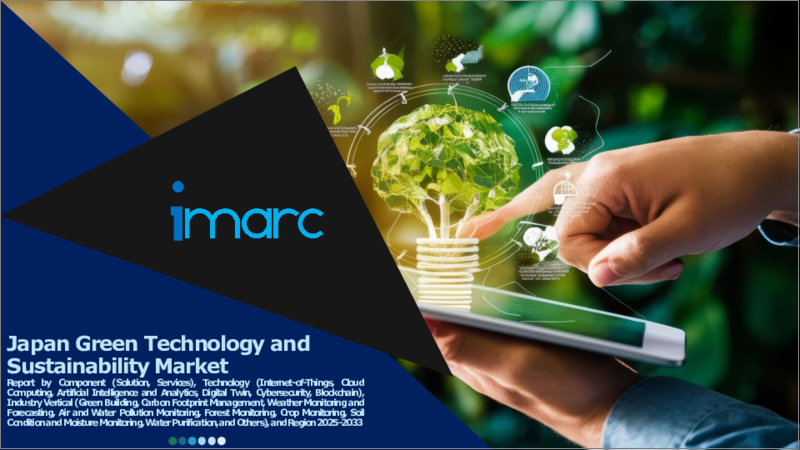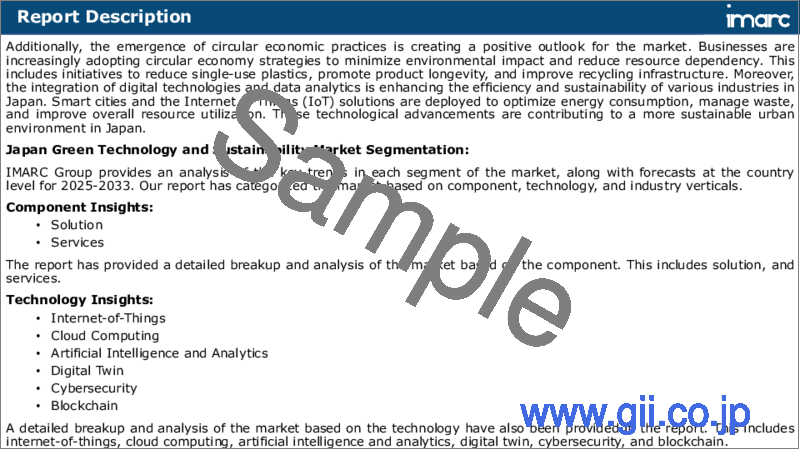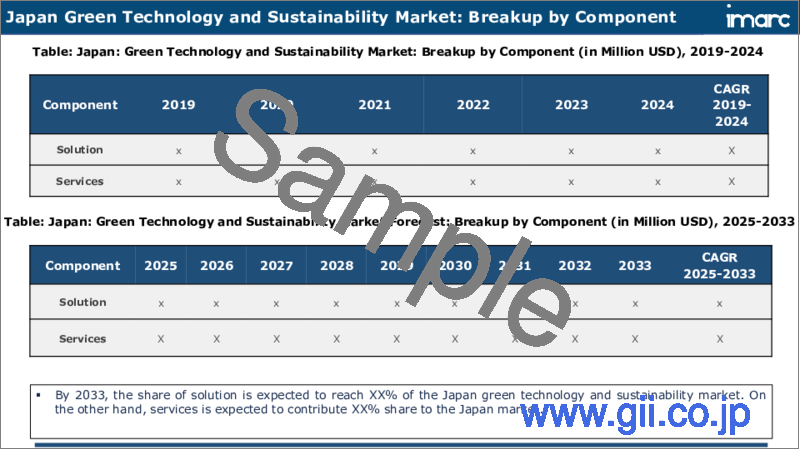|
|
市場調査レポート
商品コード
1609670
日本のグリーンテクノロジーおよびサステナビリティ市場レポート:コンポーネント、技術、業界、地域別、2024年~2032年Japan Green Technology and Sustainability Market Report by Component, Technology, Industry Vertical, and Region 2024-2032 |
||||||
カスタマイズ可能
|
|||||||
| 日本のグリーンテクノロジーおよびサステナビリティ市場レポート:コンポーネント、技術、業界、地域別、2024年~2032年 |
|
出版日: 2024年12月05日
発行: IMARC
ページ情報: 英文 121 Pages
納期: 5~7営業日
|
- 全表示
- 概要
- 目次
日本のグリーンテクノロジーおよびサステナビリティ市場の市場規模は2023年に41億8,000万米ドルに達しました。今後、IMARC Groupは、市場は2032年までに434億2,000万米ドルに達し、2024年から2032年の間に26.30%の成長率(CAGR)を示すと予測しています。環境と社会的責任に対する個人や企業の意識と関心の高まり、循環型経済の実践の出現、環境衛生を促進するための行政当局からの支援の高まりは、市場を牽引する主要因のいくつかです。
本レポートで扱う主な質問
- 日本のグリーンテクノロジーおよびサステナビリティ市場はこれまでどのように推移してきたか?
- COVID-19が日本のグリーンテクノロジーおよびサステナビリティ市場に与えた影響は?
- 日本のグリーンテクノロジーおよびサステナビリティ市場のコンポーネント別の内訳は?
- 日本のグリーンテクノロジーおよびサステナビリティ市場の技術別の内訳は?
- 日本のグリーンテクノロジーおよびサステナビリティ市場の業界別内訳は?
- 日本のグリーンテクノロジーおよびサステナビリティ市場のバリューチェーンにはどのような段階があるのか?
- 日本のグリーンテクノロジーおよびサステナビリティにおける主な促進要因と課題は何か?
- 日本のグリーンテクノロジーおよびサステナビリティ市場の構造と主要プレーヤーは?
- 日本のグリーンテクノロジーおよびサステナビリティ市場における競合の程度は?
目次
第1章 序文
第2章 調査範囲と調査手法
- 調査の目的
- ステークホルダー
- データソース
- 市場推定
- 調査手法
第3章 エグゼクティブサマリー
第4章 日本のグリーンテクノロジーおよびサステナビリティ市場:イントロダクション
- 概要
- 市場力学
- 業界動向
- 競合情報
第5章 日本のグリーンテクノロジーおよびサステナビリティ市場情勢
- 過去および現在の市場動向(2018~2023年)
- 市場予測(2024~2032年)
第6章 日本のグリーンテクノロジーおよびサステナビリティ市場:コンポーネント別の内訳
- ソリューション
- サービス
第7章 日本のグリーンテクノロジーおよびサステナビリティ市場:技術別の内訳
- モノのインターネット
- クラウドコンピューティング
- 人工知能と分析
- デジタルツイン
- サイバーセキュリティ
- ブロックチェーン
第8章 日本のグリーンテクノロジーおよびサステナビリティ市場:業界別の内訳
- グリーンビルディング
- カーボンフットプリント管理
- 気象監視と予報
- 大気汚染と水質汚染の監視
- 森林監視
- 作物モニタリング
- 土壌の状態と水分のモニタリング
- 水の浄化
- その他
第9章 日本のグリーンテクノロジーおよびサステナビリティ市場:競合情勢
- 概要
- 市場構造
- 市場プレーヤーのポジショニング
- 主要成功戦略
- 競合ダッシュボード
- 企業評価象限
第10章 主要企業のプロファイル
第11章 日本のグリーンテクノロジーおよびサステナビリティ市場:業界分析
- 促進要因・抑制要因・機会
- ポーターのファイブフォース分析
- バリューチェーン分析
第12章 付録
Japan green technology and sustainability market size reached US$ 4.18 Billion in 2023. Looking forward, IMARC Group expects the market to reach US$ 43.42 Billion by 2032, exhibiting a growth rate (CAGR) of 26.30% during 2024-2032. The increasing awareness and concern among individuals and businesses about environmental and social responsibility, emergence of circular economy practices, and rising support from governing authorities to promote environmental health represent some of the key factors driving the market.
Green technology, also known as sustainable technology, refers to the development and utilization of innovative solutions that minimize the negative impact of human activities on the environment and promote long-term ecological balance. It incorporates sustainable practices and eco-friendly materials in various sectors to reduce resource consumption, pollution, and waste generation. It emphasizes efficiency in resource use and waste management, resulting in cost savings and reduced ecological footprint. It often relies on renewable energy sources like solar, wind, and hydropower to reduce dependence on fossil fuels. It helps mitigate climate change, protect biodiversity, reduce pollution, and safeguard the planet for future generations. It enables businesses and individuals to benefit from reduced energy bills, lower operational costs, and potential incentives for adopting green practices.
Japan Green Technology and Sustainability Market Trends:
The increasing awareness and concern among individuals and businesses about environmental and social responsibility represent one of the primary factors influencing the market positively in Japan. People are actively seeking eco-friendly products and services, and businesses are recognizing the importance of corporate sustainability as a competitive advantage. This demand for sustainable solutions is driving innovation across various sectors, including renewable energy and electric vehicles (EVs) to waste reduction and circular economy initiatives. Furthermore, the rising focus on technological innovation and research and development (R&D) activities is contributing to the growth of the market. Along with this, continuous advancements in areas, such as hydrogen fuel cells, advanced materials, and clean energy technologies. are facilitating the market growth. Key companies in Japan are investing in research activities to develop cutting-edge solutions that address domestic sustainability challenges and have global relevance. Moreover, the expansion of renewable energy sources and the increasing support from the governing authorities of the country to promote environmental health are strengthening the growth of the market. They are offering incentives and policies, such as feed-in tariffs and regulatory reforms, making it more attractive for investors and businesses to participate in the green energy sector. Additionally, the emergence of circular economic practices is creating a positive outlook for the market. Businesses are increasingly adopting circular economy strategies to minimize environmental impact and reduce resource dependency. This includes initiatives to reduce single-use plastics, promote product longevity, and improve recycling infrastructure. Moreover, the integration of digital technologies and data analytics is enhancing the efficiency and sustainability of various industries in Japan. Smart cities and the Internet of Things (IoT) solutions are deployed to optimize energy consumption, manage waste, and improve overall resource utilization. These technological advancements are contributing to a more sustainable urban environment in Japan.
Japan Green Technology and Sustainability Market Segmentation:
Component Insights:
- Solution
- Services
Technology Insights:
- Internet-of-Things
- Cloud Computing
- Artificial Intelligence and Analytics
- Digital Twin
- Cybersecurity
- Blockchain
Industry Verticals Insights:
- Green Building
- Carbon Footprint Management
- Weather Monitoring and Forecasting
- Air and Water Pollution Monitoring
- Forest Monitoring
- Crop Monitoring
- Soil Condition and Moisture Monitoring
- Water Purification
- Others
Competitive Landscape:
The market research report has also provided a comprehensive analysis of the competitive landscape. Competitive analysis such as market structure, key player positioning, top winning strategies, competitive dashboard, and company evaluation quadrant has been covered in the report. Also, detailed profiles of all major companies have been provided.
Key Questions Answered in This Report:
- How has the Japan green technology and sustainability market performed so far and how will it perform in the coming years?
- What has been the impact of COVID-19 on the Japan green technology and sustainability market?
- What is the breakup of the Japan green technology and sustainability market on the basis of component?
- What is the breakup of the Japan green technology and sustainability market on the basis of deployment technology?
- What is the breakup of the Japan green technology and sustainability market on the basis of industry verticals?
- What are the various stages in the value chain of the Japan green technology and sustainability market?
- What are the key driving factors and challenges in the Japan green technology and sustainability?
- What is the structure of the Japan green technology and sustainability market and who are the key players?
- What is the degree of competition in the Japan green technology and sustainability market?
Table of Contents
1 Preface
2 Scope and Methodology
- 2.1 Objectives of the Study
- 2.2 Stakeholders
- 2.3 Data Sources
- 2.3.1 Primary Sources
- 2.3.2 Secondary Sources
- 2.4 Market Estimation
- 2.4.1 Bottom-Up Approach
- 2.4.2 Top-Down Approach
- 2.5 Forecasting Methodology
3 Executive Summary
4 Japan Green Technology and Sustainability Market - Introduction
- 4.1 Overview
- 4.2 Market Dynamics
- 4.3 Industry Trends
- 4.4 Competitive Intelligence
5 Japan Green Technology and Sustainability Market Landscape
- 5.1 Historical and Current Market Trends (2018-2023)
- 5.2 Market Forecast (2024-2032)
6 Japan Green Technology and Sustainability Market - Breakup by Component
- 6.1 Solution
- 6.1.1 Overview
- 6.1.2 Historical and Current Market Trends (2018-2023)
- 6.1.3 Market Forecast (2024-2032)
- 6.2 Services
- 6.2.1 Overview
- 6.2.2 Historical and Current Market Trends (2018-2023)
- 6.2.3 Market Forecast (2024-2032)
7 Japan Green Technology and Sustainability Market - Breakup by Technology
- 7.1 Internet-of-Things
- 7.1.1 Overview
- 7.1.2 Historical and Current Market Trends (2018-2023)
- 7.1.3 Market Forecast (2024-2032)
- 7.2 Cloud Computing
- 7.2.1 Overview
- 7.2.2 Historical and Current Market Trends (2018-2023)
- 7.2.3 Market Forecast (2024-2032)
- 7.3 Artificial Intelligence and Analytics
- 7.3.1 Overview
- 7.3.2 Historical and Current Market Trends (2018-2023)
- 7.3.3 Market Forecast (2024-2032)
- 7.4 Digital Twin
- 7.4.1 Overview
- 7.4.2 Historical and Current Market Trends (2018-2023)
- 7.4.3 Market Forecast (2024-2032)
- 7.5 Cybersecurity
- 7.5.1 Overview
- 7.5.2 Historical and Current Market Trends (2018-2023)
- 7.5.3 Market Forecast (2024-2032)
- 7.6 Blockchain
- 7.6.1 Overview
- 7.6.2 Historical and Current Market Trends (2018-2023)
- 7.6.3 Market Forecast (2024-2032)
8 Japan Green Technology and Sustainability Market - Breakup by Industry Verticals
- 8.1 Green Building
- 8.1.1 Overview
- 8.1.2 Historical and Current Market Trends (2018-2023)
- 8.1.3 Market Forecast (2024-2032)
- 8.2 Carbon Footprint Management
- 8.2.1 Overview
- 8.2.2 Historical and Current Market Trends (2018-2023)
- 8.2.3 Market Forecast (2024-2032)
- 8.3 Weather Monitoring and Forecasting
- 8.3.1 Overview
- 8.3.2 Historical and Current Market Trends (2018-2023)
- 8.3.3 Market Forecast (2024-2032)
- 8.4 Air and Water Pollution Monitoring
- 8.4.1 Overview
- 8.4.2 Historical and Current Market Trends (2018-2023)
- 8.4.3 Market Forecast (2024-2032)
- 8.5 Forest Monitoring
- 8.5.1 Overview
- 8.5.2 Historical and Current Market Trends (2018-2023)
- 8.5.3 Market Forecast (2024-2032)
- 8.6 Crop Monitoring
- 8.6.1 Overview
- 8.6.2 Historical and Current Market Trends (2018-2023)
- 8.6.3 Market Forecast (2024-2032)
- 8.7 Soil Condition and Moisture Monitoring
- 8.7.1 Overview
- 8.7.2 Historical and Current Market Trends (2018-2023)
- 8.7.3 Market Forecast (2024-2032)
- 8.8 Water Purification
- 8.8.1 Overview
- 8.8.2 Historical and Current Market Trends (2018-2023)
- 8.8.3 Market Forecast (2024-2032)
- 8.9 Others
- 8.9.1 Historical and Current Market Trends (2018-2023)
- 8.9.2 Market Forecast (2024-2032)
9 Japan Green Technology and Sustainability Market - Competitive Landscape
- 9.1 Overview
- 9.2 Market Structure
- 9.3 Market Player Positioning
- 9.4 Top Winning Strategies
- 9.5 Competitive Dashboard
- 9.6 Company Evaluation Quadrant
10 Profiles of Key Players
- 10.1 Company A
- 10.1.1 Business Overview
- 10.1.2 Product Portfolio
- 10.1.3 Business Strategies
- 10.1.4 SWOT Analysis
- 10.1.5 Major News and Events
- 10.2 Company B
- 10.2.1 Business Overview
- 10.2.2 Product Portfolio
- 10.2.3 Business Strategies
- 10.2.4 SWOT Analysis
- 10.2.5 Major News and Events
- 10.3 Company C
- 10.3.1 Business Overview
- 10.3.2 Product Portfolio
- 10.3.3 Business Strategies
- 10.3.4 SWOT Analysis
- 10.3.5 Major News and Events
- 10.4 Company D
- 10.4.1 Business Overview
- 10.4.2 Product Portfolio
- 10.4.3 Business Strategies
- 10.4.4 SWOT Analysis
- 10.4.5 Major News and Events
- 10.5 Company E
- 10.5.1 Business Overview
- 10.5.2 Product Portfolio
- 10.5.3 Business Strategies
- 10.5.4 SWOT Analysis
- 10.5.5 Major News and Events
11 Japan Green Technology and Sustainability Market - Industry Analysis
- 11.1 Drivers, Restraints, and Opportunities
- 11.1.1 Overview
- 11.1.2 Drivers
- 11.1.3 Restraints
- 11.1.4 Opportunities
- 11.2 Porters Five Forces Analysis
- 11.2.1 Overview
- 11.2.2 Bargaining Power of Buyers
- 11.2.3 Bargaining Power of Suppliers
- 11.2.4 Degree of Competition
- 11.2.5 Threat of New Entrants
- 11.2.6 Threat of Substitutes
- 11.3 Value Chain Analysis





